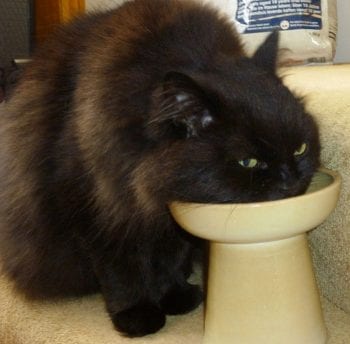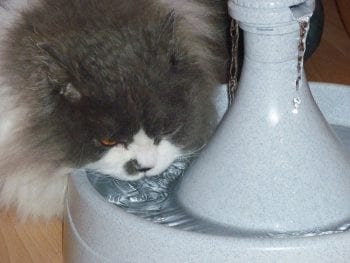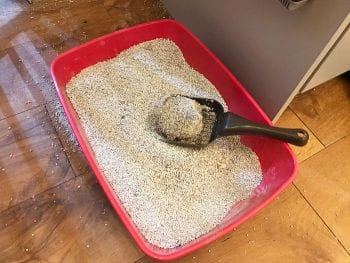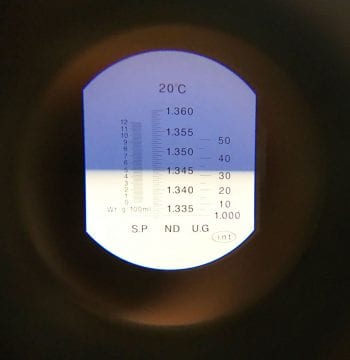28 Jan 2021
Sarah Caney BVSc, PhD, DSAM(Feline), MRCVS explains the importance of fluid intake in cats suffering from this disease and suggests various tactics to achieve this.

Figure 1. Experimenting with different types of water receptacles is helpful – this cat appreciated drinking out of a mug.
Encouraging water intake is an important recommendation in cats suffering from FLUTD, irrespective of the cause. A variety of tactics exist for achieving this, including feeding a moist diet, feeding specially formulated therapeutic urinary diets and using supplements that help increase voluntary water intake. Attention to the type, number and location of water bowls can be of help.
A successful outcome often requires some experimentation so that each cat’s individual preferences can be identified and supported. Carers can assess the success of their efforts in a number of ways, including free catch urine specific gravity measurement; an ideal outcome would be urine with a specific gravity of 1.030 to 1.035.
Encouraging drinking and intake of additional fluids is a key recommendation for all cats with FLUTD, irrespective of the cause.
Evidence to support this recommendation includes a decreased risk of recurrent obstruction in cats treated medically for urethral obstruction (Eisenberg et al, 2013) and reduced recurrence of feline idiopathic cystitis (Markwell et al, 1999; Gunn-Moore and Shenoy, 2004). The author typically aims for urine specific gravity (USG) levels of around 1.030 to 1.035 following interventions.
A number of reasons exists as to why increased fluid intake is thought beneficial in cats with FLUTD:
In general, where possible, a wet rather than dry food is recommended as a straightforward method for increasing fluid consumption. Cats eating a wet food will typically take in more fluids than they would choose to voluntarily consume if eating a dry food.
Specially formulated therapeutic urinary diets should be prioritised for cats with FLUTD since they have additional potential benefits for these cats. Nutritional strategies for management of FLUTD are discussed in more detail in a separate article.
One modification in certain dry formulations of therapeutic urinary diets is increased sodium levels, which have been shown to encourage thirst and production of more dilute urine (Hawthorne and Markwell, 2004), therefore potentially benefiting many cats with FLUTD – especially those resistant to transitioning to a wet food.
Safety data for older cats and those with renal disease have been contradictory, with one study revealing that renal parameters worsened in cats with chronic kidney disease (CKD) receiving a sodium-supplemented diet (Kirk et al, 2006), while more recent prospective studies have indicated no adverse renal or cardiovascular consequences in cats receiving the food for prolonged periods (Reynolds et al, 2013; Chetboul et al, 2014). Manufacturers of sodium-supplemented therapeutic diets currently list CKD and cardiovascular disease as contraindications to feeding this food.
Additional food-related strategies to increase water consumption
Carers should be encouraged to consider adding extra water to whichever food is being offered – wet or dry. A very gradual approach is most likely to be successful – starting by adding one to two teaspoons of warm water to the food and increasing from there, according to how well it is tolerated by the cat.
Some cats are prepared to eat a “soup” rather than standard consistency of cat food. Surprisingly, some cats will eat dry kibble with added water while refusing the moist version of the same food. If adding tap water to the food is not tolerated then adding a flavoured water (see further on) may be worth trying.
Broths can be created by carers as a supplement to a standard commercial therapeutic diet and may offer an increased possibility of fluid intake. For example, chicken or fish can be poached in water and then liquidised to make a broth.
An increasing number of commercially available complementary cat foods are now available in soup or stew formulations and may also help encourage fluid intake. Since these are complementary foods, they should be used alongside a complete cat food – ideally a therapeutic urinary diet for cats with FLUTD.
Recently, Purina launched a complementary nutritional supplement (HP Hydra Care), which has been shown to increase water intake, reduce USG and reduce urine osmolality in cats receiving it (Zanghi et al, 2018). HC Hydra Care is a nutrient-enriched soft jelly that contains whey protein, poultry digest, glycerol and electrolytes.
While low in calories, it is very palatable – cats offered a choice of tap water and HC Hydra Care preferentially consumed more of the HC Hydra Care in one study. The cats in this study were reported to produce a larger volume of more dilute urine throughout the two-month study period (Zanghi et al, 2018).
Purina recommends one 85g pouch is offered per 2kg bodyweight so, for most cats one to two pouches per day. The product should be offered in a separate bowl to food and water.

Choice of water bowl type can have an impact on voluntary water intake. Most cats prefer glass, ceramic or stainless steel bowls rather than plastic, which may taint the taste of the water. Advising carers to experiment by offering different shapes and sizes of bowl can be helpful.
Most cats like wide, shallow bowls, but some like drinking out of a tall glass, jug or even a mug (Figure 1). If a tall glass is a preferred receptacle then it can help to place this on a non-slip mat or even use adhesive stickers to reduce the risk of the tumbler being knocked over. Receptacles should be filled to the brim with a visible meniscus since cats do not like to place their heads inside bowls or touch their whiskers on the sides of bowls.
Water bowls should be available in all of the areas of the home that the cat spends time in. For example, for households on more than one level, water bowls should be present on all levels. In multi-cat households, ensuring adequate resources for all of the cats is key – as a minimum one water bowl should be available per social group, plus one extra (Ellis et al, 2013). Even better is to have one water bowl per cat, plus one extra.
For older cats, having plenty of water bowls in all locations is especially important if mobility disorders such as OA are present. Cats with OA affecting their cervical spine or forelimbs may also appreciate access to a raised food and water bowl (Figure 2).
The water bowls should not be next to a food bowl or litter tray, or in a busy or overlooked location. Instead, all bowls should be in calm, quiet places that are easily accessible to the cat.
Moving water sources are popular with some cats and may encourage drinking (Figure 3). Examples include a dripping tap/shower into a basin/bath, placing a table tennis ball in a large shallow water bowl for the cat to play with, and water fountains.
A large number of water fountains are available, but unfortunately it is not always possible to predict which of these will be popular with the cat. Some fountains have quite noisy motors, which can put off very timid cats; several are made from plastic, which may not be ideal for the cat as previously discussed.

Unfortunately, published studies show little or only a small increase in water consumption with fountains (Grant, 2010; Pachel and Neilsen, 2010) although this strategy may be successful in some individuals and was thought one factor associated with a reduced risk of recurrence in a series of cats receiving medical management for urethral obstruction (Eisenberg et al, 2013).
When attempting to encourage drinking, carers should be mindful that cats may have different preferences for water depending on the characteristics of the local tap water.
It can, therefore, be helpful to offer a variety of waters for the cat to choose from – for example tap water, collected rainwater, mineral water – and see if a clear preference is evident. The bowl should be cleaned, rinsed and water refreshed daily to avoid offering stale water.
Chilled water is likely to be less appealing; water should be offered at ambient room temperature. Individual cats have different preferences – for example, some of the author’s patients have liked licking the condensation that forms on the surface of a bottle of frozen water after its removal from the freezer and others have liked licking an ice cube added to their food or water bowl – so some experimentation is sensible.
Flavoured waters can be offered as a drink or added to the food to increase the water content. Home-prepared flavoured waters include:
In some countries, commercial flavoured waters are marketed for cats. The author has no experience of these products. Carers should avoid offering salty liquids or those containing garlic or onion, which are toxic to cats. Cow’s milk is not recommended since it may cause diarrhoea in some cats.
Risk factors for FLUTD include a sedentary lifestyle and infrequent urination. Encouraging water intake assists in encouraging more frequent urination, but it is also essential to offer optimal toileting facilities, which include the following:
When making changes to toileting facilities, carers should be advised to add new boxes that conform to the aforementioned recommendations, and allow the cat free choice between the old and new boxes. Typically, the new boxes will be preferable and once in use, the old boxes can be removed.
Any changes to the cat’s diet or water regime should be made slowly – for example, if adding water to the food then do this very gradually to encourage acceptance. Dietary transitions should take place over 5 to 10 days, rather than a shorter period.
Changes to the type of bowl used and locations should be made slowly so that carers can spot which changes are popular with the cat. Carers should be advised to be persistent and not daunted if their initial strategies do not meet with success.
Tactics to encourage fluid intake often require significant carer dedication and commitment. Having some way of assessing the success of these strategies is an advantage in motivating and supporting carers.

Monitoring options available vary according to the household set-up – for example single versus multi-cat, and whether the cat goes outside the home to drink and/or urinate.
Depending on the household set-up, it may be possible to monitor the following:
While this article has focused on the benefits and strategies for increasing fluid intake in cats with FLUTD, other situations exist where encouraging drinking may be beneficial, including:

A variety of tactics can be helpful in increasing fluid intake in cats with FLUTD and are likely to reduce the risk of recurrent FLUTD. Carers should be encouraged to try as many of the aforementioned tactics as they can and to support whichever tactics work for their cat.
It is often possible to achieve good results through use of one or more of the strategies described. Monitoring USG is often helpful in supporting and motivating carers to continue to encourage fluid intake in their cat.